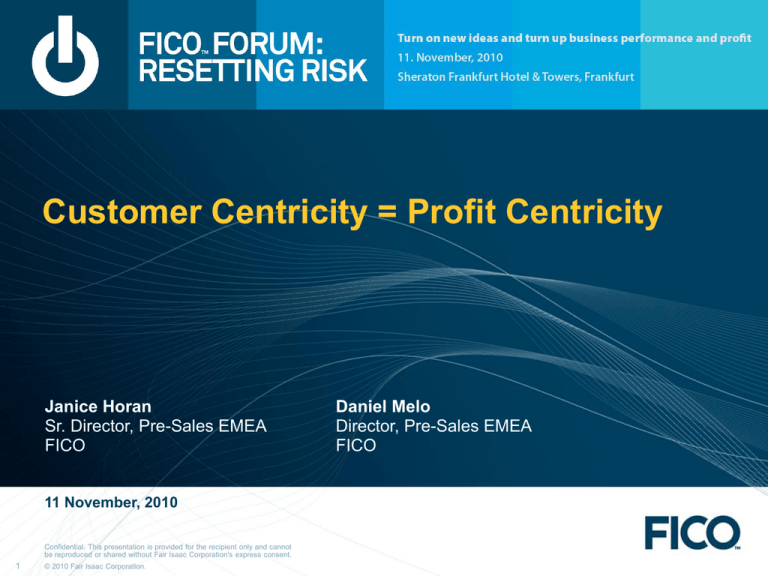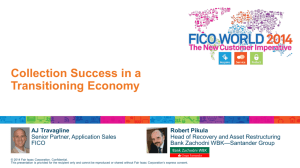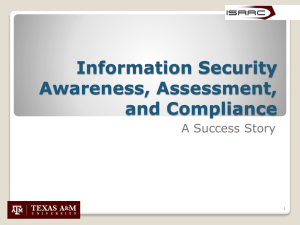Customer Centricity = Profit Centricity
advertisement

Customer Centricity = Profit Centricity Janice Horan Sr. Director, Pre-Sales EMEA FICO 11 November, 2010 Confidential. This presentation is provided for the recipient only and cannot be reproduced or shared without Fair Isaac Corporation's express consent. 1 © 2010 Fair Isaac Corporation. Daniel Melo Director, Pre-Sales EMEA FICO Agenda » Setting Context: Intensified Competition » Historical Trend: Personalizing Products, Depersonalizing Treatments » Customer Centricity in Practice » Summary 2 © 2010 Fair Isaac Corporation. Confidential. © 2010 Fair Isaac Corporation. Confidential. Indebtedness Rose as Consumer Inhibitions Relaxed Global consumerism driving increased indebtedness and insolvency Relaxed attitudes toward debt evident higher delinquencies, more bankruptcies and foreclosures 3 © 2010 Fair Isaac Corporation. Confidential. Europe, Middle East, Africa All Experienced Sizeable Expansion of Credit Markets » 2003 — 2006 represented remarkable growth European, Middle Eastern and African markets with 11 markets having almost € I Trillion in outstandings, and total period growth at 21% TOP EMEA MARKETS Consumer Credit Outstanding, 2003—2006 percentage growth UK ESP NL IT GRE GER FR 20,096 ESP 33% RUS POL 280,810 TKY 253% 581% RSA € mm UK 15% TKY TOP EMEA MARKETS Consumer Credit Outstanding, 2006 74,159 RUS 1,772 RSA 92% POL 40% 77,585 843 NL 2% IT 43% GRE 25% 64,390 15,550 GER 5% FR 14% All data sourced through Euromonitor, January 2007 4 17,611 © 2010 Fair Isaac Corporation. Confidential. 242,700 129,100 Most European Markets Expected To Continue Growth Through 2010 IMMATURE WESTERN EUROPEAN MARKETS EXPECTED TO HAVE MOST RAPID GROWTH, 2006-2010 Turkey Turkey 17.6% Greece Greece 14.8% Spain 37,558 Spain 10.4% Ireland 7.2% Ireland France 7.0% France Belgium 6.9% Belgium UK 169,090 87,048 13,280 206,644 13,602 UK 6.2% 437,817 Denmark 5.9% Denmark 39,972 Norway 5.7% Norway 44,336 Portugal 5.6% Portugal 7,490 Austria 5.6% Austria 8,861 Sweden Luxembourg Italy Finland 4.8% Sweden 4.2% Luxembourg 4.2% Italy 3.5% Finland Germany 2.6% Germany Netherlands 2.4% Netherlands Forecasted annual growth in gross advances, CAGR 06f-10f 11,982 2,266 68,332 17,242 96,622 11,566 Forecasted gross advances in 2010, EURm Note: Please refer to the country profiles for detailed information on the forecasts for each market. Source: Datamonitor, central banks and other statistical sources 5 © 2010 Fair Isaac Corporation. Confidential. Mortgage and Consumer Credit Dominate Debt Loads for G-7 and EU Countries COMPOSITION OF OUTSTANDING LOANS TO THE HOUSEHOLD SECTOR IN EU COUNTRIES, THE US, JAPAN, CANADA AND AUSTRALIA, BY TYPES OF LOAN (2006) Source: ECRI Statistical Package 2007 6 © 2010 Fair Isaac Corporation. Confidential. Global Credit Environment – The Economy Today » Economic Turmoil: Unprecedented and continuing combinations of recovery and reversals » Reduced Public Spending: General concerns over withdrawal of stimulus, reduction in fiscal spending, government budget cuts throughout EU » Sovereign debt a concern especially for Portugal, Ireland, Greece and Spain » UK: Growth with disturbing continuance of unemployment, housing malaise » Ireland: 36% average reduction in housing prices with market still falling » Spain: Unemployment above 20%, property market still falling » US: Bailouts being paid back, increased regulatory control of credit markets, reduced credit demand, lack of consumer confidence, lingering foreclosure problem hampering housing market recovery Source for all data: www.Dismal.com Moody’s Economy.com, October 2010 7 © 2010 Fair Isaac Corporation. Confidential. The Environment in Which You Manage » Grow the portfolio » Increase margins » Reduce losses » Enhance profitability » Integrate acquisitions » Spend less to process more » Comply with an increasing number of regulations » Insure data security » Avoid public relations embarrassment 8 © 2010 Fair Isaac Corporation. Confidential. More Complex Relationships, More Channels, More Payment Competition » Creditors increasingly interacting with customers on the basis of their preferences and convenience » Utilizing letters and phone calls almost universally » Increasingly, experimenting with SMS text messaging, e-mail contact, contact with cell phones » Mobile banking another wrinkle » Anonymity of internet payment portals proving very attractive to debtors » Higher payment amounts » Higher rate of kept promises » Lower collection cost » Customers have gained leverage through ease of information access, convenience of mobile access 9 © 2010 Fair Isaac Corporation. Confidential. Fighting for Payment Share » Evidence that payment hierarchy has evolved, making capture of payment share increasingly difficult Then Now 10 © 2010 Fair Isaac Corporation. Confidential. Targeted Risk Approaches All the More Critical » Most consumers averse to debt » Many consumers reluctant to spend » Debtors experience profound humiliation when delinquent, react badly to brute force collection techniques » ‘Cumulative effect’ of all collection efforts reinforces humiliation » Almost half (49.8%) of the individuals filing bankruptcy said that aggressive collection tactics caused their decision to file » Collectors report that others who are “nicer” to the delinquent customer got paid; they didn’t 11 © 2010 Fair Isaac Corporation. Confidential. Evolution of Attitudes Towards Credit: A Return to Lenders’ Historic View » Give credit only to people who don’t need credit. Increase approval standards or exit higher risk product areas in economic down-turn » Rely on the 5 C’s, personal references, and status of existing customer relationships in decisionmaking for consumer credit » Aggressively pursue delinquent payment through phone calls, letters, statement messages, sometimes using harsh tone of voice and dialogue. Rely on manual intervention to execute collections strategy » View use of cash advances and high revolving utilization as high risk behaviours » View ‘the coupon book’ or monthly statement as the primary customer account management communication 12 © 2010 Fair Isaac Corporation. Confidential. Traditional Attitudes Had Evolved To Create Credit Products Emphasizing Flexibility and Convenience. . . » A more savvy, demanding consumer » Multiple communication channels, including branch, mail, phone and internet driving change in consumer leverage » Significant increase in competition for wallet share even as financial service and banking sectors consolidate » One-size-fits-all products giving way to targeted marketing and flexible product design » “Rewards” for transaction volume increases » Low financing rates promoting balance transfers » “Marketing to one” and “CRM” sales focus » Fewer customers interested, fewer able to qualify 13 © 2010 Fair Isaac Corporation. Confidential. Changing Consumer Attitudes Through Product and Technology Advancement. » ATM transactions encouraged – fees charged for more expensive teller transactions » Online banking emerged, begat mobile banking » Websites promoted borrowing tools, wealth, investment services and business services, including “easy online instant applications.” » Together with utility, retailer and lenders, bank websites that offered: » Great rates, rewards, sweepstakes, balance transfer offers and usage promotions – Choose the product that’s right for you! » Market to niche populations for credit: affinity groups; preferred customers; ethnic communities; specific demographic and lifestyle segments. » One-stop product and service bundling. 14 © 2010 Fair Isaac Corporation. Confidential. Proliferation of Channels, Products Perceived Differently by Banks, Consumers Bank Self-Perception 15 © 2010 Fair Isaac Corporation. Confidential. Consumer Perception of Banks Adaptive Control Systems Created Benefit at the Account Level, yet… » Focus on product or product sub-population misses “halo effect” » Studies since the early 90’s suggest a “Halo Effect” – Customers having multiple relationships with a bank tend to behave better and more profitably across all relationships than do customers with only a single relationship » Halo Effect may be » a form of ‘brand loyalty’ or » a fear of embarrassment (will my local teller know that I missed a loan payment?) » Halo Effect is associated with very real benefits 16 © 2010 Fair Isaac Corporation. Confidential. Technology and the CRM Dynamic Caused Depersonalisation » As product designs and marketing worked toward marketing to one, collections processes became increasingly depersonalised » Branch functions moved to centralized call centres and processing locations, sometimes offsite, sometimes off-shore » Data came from centralized repositories and databases, instead of from hand-written files and notes » Scoring became the determinant of ‘character’ and ‘capacity’ » “Dialling for dollars” replaced by the auto-dialler / predictive dialler function » Speaking to a collector replaced by “Please touchtone or speak your account number . . . and press “0” to speak to an operator” 17 © 2010 Fair Isaac Corporation. Confidential. Customer Centric Management: The Business Case » Customer centric risk management means greater exposure control » Customer centric risk management means significantly improved customer retention » Customer centric risk management enables balancing of liability and credit opportunities across the customer relationship » Customer centric risk management means lower credit losses » Customer centric risk management can create regulatory compliance and may ultimately lower capital requirements 18 © 2010 Fair Isaac Corporation. Confidential. Customer Management: The Value of a Customer View » Regulation increasingly stressing need for identification of borrower exposure across the enterprise » Today, only 31% of responding North American issuers have systems allowing customer view and more than 85% of issuers set policies at account level 8.8 Coincident Loss Rate 8.6 Coincident loss rates are 14% lower on average for issuers with customer views, while Fair Isaac experience suggests even greater difference in results. 8.4 8.2 8 Rate 7.8 7.6 7.4 7.2 7 6.8 19 Account-Only View © 2010 Fair Isaac Corporation. Confidential. Customer View Results of Adaptive Control and Collections Automation Techniques at the Customer Level » Increasingly, FICO clients seek to bundle financial service products, and address their customer’s credit performance across all of their product relationships. » One TRIAD Customer Manager client using its full customer view Doubled size of its client base in one year. Reduced 90 day delinquency by over 40%. Reduced loan loss provisions by 60%. » Another TRIAD client using it for multiple relationship view, and seeking to automate its account management functions while not losing site of high risk accounts: Increased response rates and amounts borrowed by 17% on key products while reducing losses. Reduced back office staffing by 90%. » Benefits derived through combined effect of better resource prioritization and allocation while seeing the sum of the parts to address the whole customer relationship. 20 © 2010 Fair Isaac Corporation. Confidential. Where Customer Centric Focus Exists….and Where It Does Not: Database Marketing » Market saturation, affinity products, aggressive growth strategies create multiple exposures within the same customer and household wallet » Aggressive pace of mergers and acquisitions created overlapping product exposures within the organization » Focus toward Customer Centricity first began through a process of investment in CRM databases Combined portfolio Original Lender 21 © 2010 Fair Isaac Corporation. Confidential. Acquired Lender with overlapping customer relationships Where Customer Centricity Is Practiced….and Where It Is Not: Sales » Frequently associated with sales and marketing CRM focus » Multiple surveys showed that CEOs could not determine return on CRM investments if database or sales only focus » CEOs could define operational and loss savings where customer view fully embraced in risk management and corporate psychology 22 © 2010 Fair Isaac Corporation. Confidential. Where Customer Centricity Is Practiced….and Where It Is Not: One -Stop Collections » Second most frequent early adoption of customer focus was in the collections function » One-stop collections processing grew through customer demand » Customers complained about receiving 3 calls about 3 different delinquent products with the same organization, creating stronger sense of humiliation 23 © 2010 Fair Isaac Corporation. Confidential. Where CRM Is Practiced…. Europe, Canada, South America…. » Europe, Canada and South America embraced the customer management model first » Privacy restrictions preventing pre-screening caused financial service companies to look inward » Less likelihood of access to positive data within bureaux data required closer look at customer’s internal behaviour » Economically proven more expensive to book new customers than to cross-sell to existing customers 24 © 2010 Fair Isaac Corporation. Confidential. Where CRM is practiced…. Asia Pacific » Asian market lagged in infrastructure investment » Past reliance on labour intensive methods – now intent on “leap-frog” development of infrastructure » Bureau data typically ‘negative only’ or restricted use permitted » Yet World Bank indicates Asia ahead of Europe in bureau sophistication and access » And Australian banks highly customer focused 25 © 2010 Fair Isaac Corporation. Confidential. Where CRM Is Practiced….and Where It Is Not: The United States…. » US growth and account focused » Pursue growth through mass marketing, enabled by pre-screening » Positive bureau data, bureau scores created external customer view 26 © 2010 Fair Isaac Corporation. Confidential. CRM – Customer Relationship Management vs. CCM – Customer Centric Management » Highest investment returns for CRM occur where Centricity involves Risk Management » Current customer risk management capabilities include: » Customer level scores, analytics, treatments 537 - 616 429 - 588 278 - 783 690 - 631 454 - 166 583 - 926 » Inclusion of deposit, current account » » » » relationships Customer delinquent and overlimit collections Customer exposure management Customer communications and crossselling Customer level authorizations » Customer level reporting and analysis » Customer Centric Decision Models (optimised strategies) » Economic Impact Assessment » Decision Graph strategy visualization 27 © 2010 Fair Isaac Corporation. Confidential. A164CJ00Y8139PZ 0101010111010 1101001101001 0101110011010 1001010101001 IIIIIIIIIIIIIIII Chief Challenges of Customer Centricity 537 - 616 429 - 588 Defining “Customer” Defining Strategy Ownership 278 - 783 690 - 631 454 - 166 583 - 926 Agreeing to “Bad” Definitions A164CJ00Y8139PZ Aggregating Development Data 0101010111010 1101001101001 0101110011010 1001010101001 28 © 2010 Fair Isaac Corporation. Confidential. Coordinating Product and Customer Issues Maintaining Political Will to Manage the Customer IIIIIIIIIIIIIIIIIIII IIIII Summary and Conclusions » Technology has simultaneously enabled the development of highly targeted, flexible and convenient contact, and the depersonalization of the customer interaction » Debtor payment priorities and customer loyalties are influenced by both technical and philosophical / ‘friendly’ treatment approaches. » ‘Friendly’ treatment requires more targeted and precise approaches, supported by customer level analytics, treatments and decision models. » Customer Centricity drives Customer Profitability, increases satisfaction, decreases losses and capital needs 29 © 2010 Fair Isaac Corporation. Confidential. 537 - 616 429 - 588 278 - 783 690 - 631 454 - 166 583 - 926 A164CJ00Y8139PZ 0101010111010 1101001101001 0101110011010 1001010101001 IIIIIIIIIIIIIIIIIIII IIIII THANK YOU 11 November, 2010 Confidential. This presentation is provided for the recipient only and cannot be reproduced or shared without Fair Isaac Corporation's express consent. 30 © 2010 Fair Isaac Corporation.



